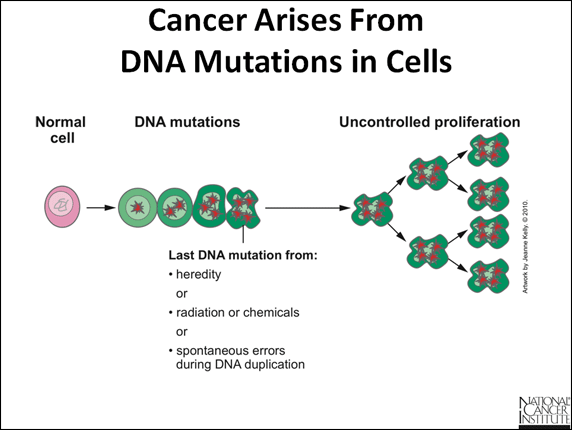
6 Hallmarks of Cancer
Highlights
Outcome

Demonstrates how gene mutations occur and the affects of them.
Defines oncogene and provides an example
Gene Mutation
Oncogene
Cell Cycle
Summarizes the importance of the 6 Hallmarks & the 4 new hallmarks
Explains the cell cycle
The 6 Hallmarks of cancer (right) show that there are some characteristics that are specific to cancer. Below are the 6 outcomes and their brief definition:
1. Resisting cell death- The cell avoids apoptosis through various pathways depending on which protein in mutated.
2. Inducing angiogenesis- The cell creates its own blood supply in order to keep the cells alive and rapidly multiplying.
3. Sustaining proliferative signaling- The signaling for the cell to stop reproducing is never turned off and the cells continue to replicate
4. Activation invasion and metastasis- The cancer cell has the ability to move from one primary site to another
5. Enabling replicative Immortality- The cell lives much longer than what it is suppose to
6. Evading growth suppressors- The growth suppressors are never turned on ( they are blocked and mutated) and will result in cell survival
The video to the left explains what the 6 hallmarks are and recent studies show that there are 10 Hallmarks of cancer now. Below there is a link explaining the 10 Hallmarks of cancer and of the paper that was published. in 2011. This list adds on an addition 4 hallmarks of cancer:
1. Deregulation of cellular energetics- Malignant tumor cells have the ability to alter cellular energetics ( Example: aerobic glycolysis)
2. Tumor promoting inflammation- the immune system has the ability to turn traitor protein and promote cancer cell development. This will result in the presence of white blood cells in tumors and shows that inflammation is linked to cancer.
3. Avoiding immune destruction – Disrupts the cancer immunity system which allows the cell to become undetectable by the immune system. (link below)
4. Genome instability and mutation- increased frequencies of mutations within the genome and can includes changes in chromosomal arrangement.
What is new with the hallmarks of Cancer? According to the news from usnews.com there was an implication of Netflix where they choose to improve awareness for the hallmarks of cancer by providing movies about tumors and the future. Below is the link for the article.
There are 2 main types of mutations:
Hereditary- Inherited from parents and are present through one’s life
Somatic Mutations- Mutations that occur during a person’s life and are only present in certain cells and not the entire body
Types of Somatic Mutations
Missense- change in 1 DNA base pair & results in the substitution of one amino acid for another in the protein made by a gene
Nonsense mutations- when one DNA base pair is substituted and the altered DNA sequence and premature signals the cell to stop building a protein.
Framework shift- addition or loss of DNA bases and results in the change a gene’s frame (three bases replaces one base)
Insertion- changes in the number of DNA bases in a gene by adding a piece of DNA
Deletion- changes in the number of DNA bases in a gene by removing a piece of the DNA
Duplication- piece of the DNA that is abnormal is copied 1+ times
Repeating Expansion- a nucleotide repeats ae short DNA sequences that are repeated a number of times


In the above link titled Thousands of rare cancer-related gene mutations found. This article explains the possibilities that will occur with the new discoveries because these mutations were pervious ignored. They are focusing on perusing the protein domain.
Proto-oncogenes are genes that normally help cells growth. This is important because when proto-oncogenes mutate they:
1.Too many copies
2. Causes for the genes to turn on forever (this is called an oncogene).
What activates oncogenes?
Chromosome rearrangements: change in a chromosome that put one oncogene next to another and allows one gene to activate the other.
Gene Duplication: having too many extra copies which will lead to making too many of a certain protein.
In the science daily there is an article that shows new research that if epigenetics is disrupted, it may switch on oncogenes

The first video to the left shows the basics of the cell cycle for the MCAT and the second video shows the cell cycle of mitosis. Also, I provided a PowerPoint slide to help with the overview of the cell cycle. The cell cycle is important to cancer development because cancer is caused by uncontrolled cell growth. This means that the cell do have genes that mutate and will cause center pathways to be mutated or blocked and can cause cancer. In a new study there are trying to figure out how to use nature’s mutated cells back into normal cells ( link below).
Tumor Suppressor genes
A tumor Suppressor Gene is a gene whose product provokes functionality favorable to cancer and therefore loss or mutation of these leads to tumor formation. It is also a gene which a germline mutation predisposes individuals to cancer. Some tumor suppressor proteins normally increase/ upregulate antigenic inhibitors, but when these are mutated, anti-angiogenic activity decreases. An example can be seen through the transcription factor, p53. It normally binds to and activates the promoter of the Thrombosponding-1 gene. Mutations of p53 are associated with phenotype and will result in the decrease of the angiogenic inhibitor so that the angiogenic switch to angiogenesis. In the link(left) will be able to see all of the genes that are tumor suppressor genes and when they are mutated they will result in cancer. Also, below is a video to compare and contrast oncogenes and tumor suppressor genes.

Explains the cell cycle
